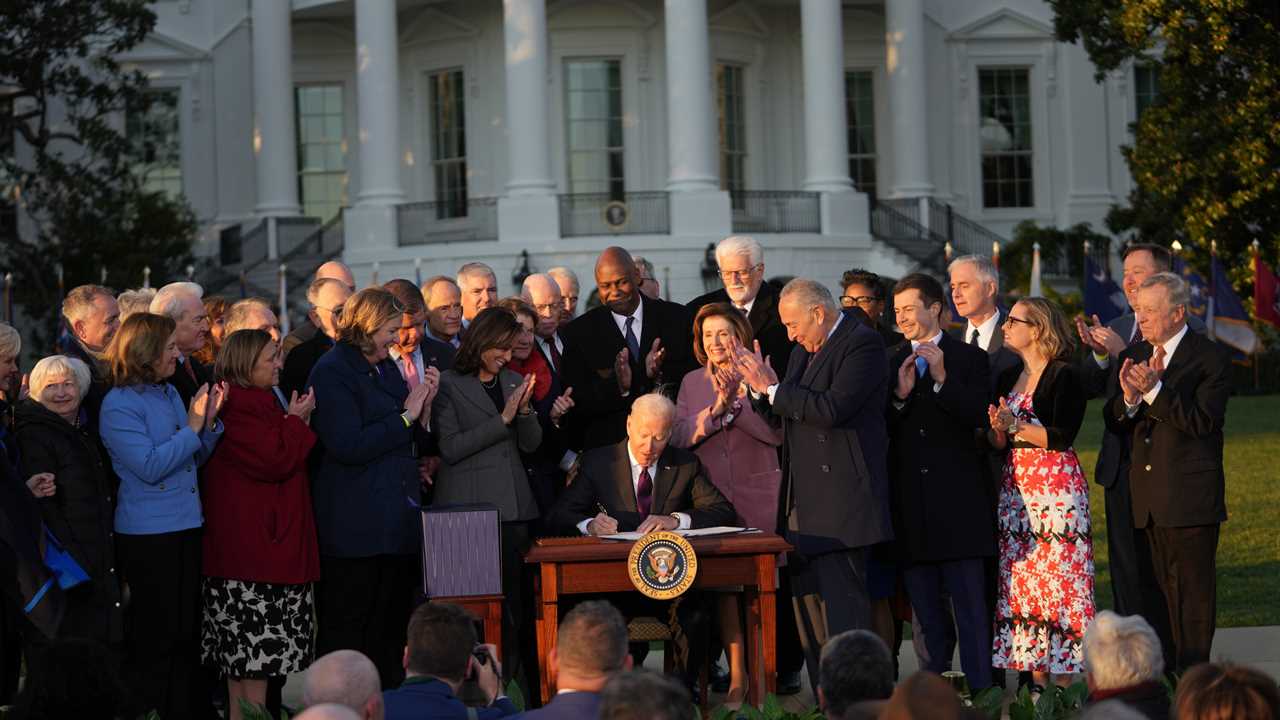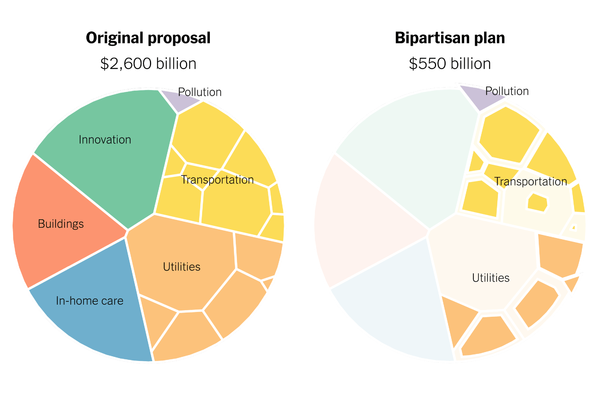
WASHINGTON — President Biden signed a $1 trillion infrastructure bill into law on Monday afternoon, a bipartisan victory that will pour billions into the nation’s roads, ports and power lines.
While the bill stopped short of realizing his full-scale ambitions for overhauling America’s transportation and energy systems, Mr. Biden pointed to it as evidence that lawmakers could work across party lines to solve problems in Washington and said it would better position the United States against China and other nations seeking to dominate the emerging industries of the 21st century economy. Hours before a virtual summit with President Xi Jinping of China, whose infrastructure initiatives have helped vault China to global leadership in advanced manufacturing and other areas, Mr. Biden said the bill showed democratic governments can deliver for their citizens.
“My message for the American people is this: America’s moving again, and your life’s going to change for the better,” Mr. Biden said during remarks at the White House.
But it will not address the nation’s entire backlog of needed infrastructure investments, and it is not as ambitious as Mr. Biden’s initial $2.3 trillion proposal. The compromises that were needed to win over a large group of Senate Republicans pared back the president’s ambitions for investing in “human infrastructure” like home health care and fortifying the nation’s physical infrastructure to fight and adapt to climate change.
Still, administration officials and a wide range of outside economists and business groups largely agree that the measure is the most important step in a generation toward upgrading critical infrastructure — and that it could soon begin to pay dividends for a wide range of businesses and people, from electric vehicle manufacturers to rural web surfers.
Some of the first bursts of spending will go toward areas that Mr. Biden prioritized in negotiations, like tens of billions of dollars to improve access to broadband internet and to replace hazardous lead drinking pipes nationwide. Spending has already been announced to help clear backlogs at the nation’s ports, which are contributing to shipping delays and price increases as the United States sees a pandemic surge in demand for consumer goods, many of which are imported.
The infrastructure spending will not jolt the American economy like a traditional economic stimulus plan, nor is it meant to. Officials say the administration will focus as much on “shovel-worthy” projects — meaning those that make the most of federal dollars — as they will on “shovel-ready” ones that would dump money into the economy more quickly. The package was designed to deliver money over several years, in part to avoid fueling more price increases across an economy that is experiencing its highest inflation rate in decades.
Mr. Biden and his advisers say they expect the package to deliver a variety of benefits that will power economic growth over time, including leaner supply chains, faster and more equitably distributed internet access and improved educational outcomes for children who will no longer be exposed to water-based lead that stunts brain development.
The challenge for Mr. Biden is to convince an increasingly uneasy American public that the bill will lead to improvements in their lives. Soaring prices for food, gas and household items have chipped away at the president’s approval ratings.
“This is not designed to be stimulus,” Cecilia Rouse, who chairs the White House Council of Economic Advisers, said in an interview. “It’s designed to be the most strategic, effective investments so that we can continue to compete against China and other countries that are making bigger investments in their infrastructure.”
“We will see investments starting next year,” she added, “beginning with our ports, and beginning with other areas where we know we are far behind.”
Other core components of the bill include money meant to build as many as 500,000 electric vehicle charging stations and improve the nation’s electric grids, as part of an effort to speed the transition to energy and transportation systems that burn fewer of the fossil fuels that are warming the planet.
“With the combination of this investment and where we know the industry is going,” said Brian Deese, who heads Mr. Biden’s National Economic Council, “we believe this will be the beginning of a real transformation in our vehicle infrastructure.”
It also features tens of billions each for rebuilding roads and bridges, upgrading freight and passenger rail systems and cleaning up environmental pollution.
The legislation was the product of intense negotiations spanning much of the first year of Mr. Biden’s presidency, and of the back-slapping, coalition-building politics the president has relished in a government career stretching back to the 1970s. Mr. Biden brokered agreements first with Senate Republicans, 18 of whom ultimately voted for the bill, and then with progressive Democrats in the House, who held up its final passage in order to raise pressure on centrists in Mr. Biden’s party to support a larger spending bill focused on climate change, early childhood and a wide range of social policy.
About $550 billion of the bill represents an increase over current spending levels. Researchers at the nonpartisan Metropolitan Policy Program at the Brookings Institution estimate that money will increase federal infrastructure spending as a share of the economy by half over the next five years, putting it nearly on par with the infrastructure provisions of the New Deal under President Franklin D. Roosevelt. If Mr. Biden’s $1.85 trillion spending bill — including more spending on climate — also passes the House and Senate, they estimate, the increased infrastructure spending will eclipse the New Deal.
That increase will challenge the government’s ability to spend money on time and effectively. On Sunday, Mr. Biden appointed Mitch Landrieu, the former mayor of New Orleans, to oversee that effort.
“Implementing a historic bill like this will test all of our management facilities,” said Adie Tomer, who leads the Metropolitan Policy Program’s infrastructure work. The challenges, he said, include “hiring federal, state, and local officials to direct programming; finding enough skilled tradespeople to execute the work; and securing equipment and materials during a major supply chain crunch.”
Liberal economists fault the package for not spending enough, particularly on climate.
“Overall, the bill is a step in the right direction,” said Mark Paul, an economist at the New College of Florida. “But we need far, far more investment in infrastructure — from the care economy to the green economy — if we are to build a strong and resilient economy for the 21st century.”

The Infrastructure Plan: What’s In and What’s Out
Comparing the infrastructure plan President Biden proposed in March with the one the Senate has passed.






